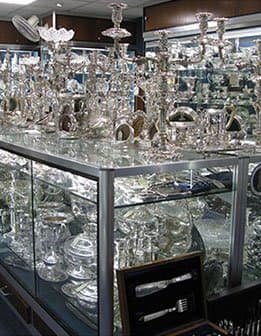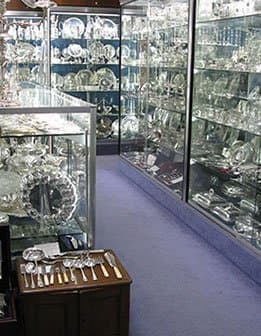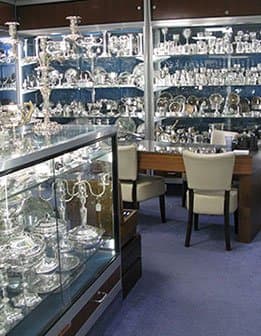Before I answer the question in the title, I would just like to explain the terms flatware and cutlery. If one were being pedantic, spoons and forks should be referred to solely as flatware and knives as cutlery. Due to the passage of time, cutlery is now the dominant term for both knives, forks and spoons in England whilst the correct term flatware – for spoons and forks – is still used more commonly (correctly) in America.
A cutler in earlier times only ever made knives and a flatware maker spoons and forks. This is the reason why in an old set of flatware, the knives tend to be made by a different maker. When one considers buying cutlery or flatware (whatever your preference!) it makes little or no sense in buying newly made. Why is that you may ask? Quality and price are the two main reasons. When cutlery was made in the 18th and 19th centuries, and in the early part of the 20th, it was made by the hand forging process.
A spoon and fork were hammered and shaped from a block of silver by hand which was a lengthy and laborious process. Nevertheless, when a spoon or fork is made by hand the repeated hammering and annealing processes involved eventually stiffen the spoon so it will feel like sprung steel if one tries to bend it. When a spoon or fork is made today, or in the last say 80 years, they are generally stamped on a machine which gives the metal far less durability to wear and tear as it lacks the tensile strength of the hand forged product (and also makes the shapes of the bowls of the spoons and tines of the forks less attractive). If the cutlery has a pattern to it, a modern machine-made set would have far less definition than the antique equivalent. It is for these reasons that a 200-year-old cutlery set is generally found in better condition than a 50-year-old machine-made set.
Why do people buy new then? My answer would probably be ignorance (I don’t wish to sound rude). Why would one buy an inferior machine-made modern cutlery set which will cost approximately three times as much as a hand forged antique set from 100 or 200 years ago. If one were to make a modern hand forged set to rival those of yesteryear, one would be talking five times the cost of the antique equivalent. The word for example “handcrafted” or “handmade” is often used today rather disingenuously (it normally means someone at sometime during the machine manufacturing process has touched it!) When making silverware (or most other products) it always must be kept in mind that labour rates were far cheaper years ago (perhaps three to four times lower than today). On the flip side, raw materials were far more expensive – silver compared to today’s inflation adjusted was about four times the price in the 18th century.
Antique silver cutlery makes a beautiful statement on any table and is extremely undervalued. I was wandering through a large London department store (I won’t name it!) the other day and stopped to look at a display of modern machine-made cutlery (described as handcrafted). I looked at the individual price list and they were selling a new sterling silver old English pattern table fork for £375. I can sell about four 18th century, beautifully made originals for that price or a set of six forks machine-made (second hand as new). When it comes to knives the debate over old or new shifts somewhat as compared to the debate over spoons and forks.
Customers often come in and say to me “why have I not got any knives with an antique set of cutlery”. Most people don’t realise that stainless steel (as known today) was only invented in 1913. Previous to this, knives were all carbon steel and had to be sharpened and oiled (to prevent corrosion). So although I keep a large stock of early knives – both with original blades and sometimes re-bladed with stainless steel blades – I would often recommend buying more recent knives with antique cutlery sets. Unlike the making of spoons and forks which has clearly regressed over the centuries, knife technology has moved on somewhat. Most pre-First World War knives used a pitch (tar) filling to attach the handle to the blades. Nowadays an epoxy resin is used. This means that modern knives can generally be put in dishwashers. Boiling water or dishwashers would generally cause the blade to come out of the handle on old knives which can be rectified but not ideal. Knives were traditionally made in silver, bone or after about 1915 bakelite or some other composite material as well. Contrary to popular belief, silver can be put in the dishwasher although it is always best to separate the knives. Never let the knife blades touch the rest of the spoons and forks as there is a chance that the stainless-steel blades will get marked due to a form of electrolysis that takes place between the silver and the steel. The use of silver cutlery apart from aesthetic considerations is also beneficial on a hygiene and health level. Silver, along with gold and to a lesser extent copper, has a powerful antibacterial effect which stainless steel doesn’t. Any germs that touch silver are neutralised (even if you haven’t cleaned the silver).
At William Walter Antiques we have an enormous quantity of antique silver flatware and cutlery both in the form of complete sets and loose pieces. Many clients are missing a few pieces from their existing sets, and we are normally able to help.
If you have any queries concerning flatware/cutlery, please do not hesitate to contact us. We also probably have one of the largest collections of early spoons – including the earliest hallmarked spoon in the world for sale at the moment (1528) and the finest set of twelve Tudor period spoons seen this century.
Our Makers
An A to Z list of silversmiths featured on our website
About Us
If you see something in Archive that you would have liked please contact us as we might be able to source
Our Store
Our store is situated in vaults 3 and 5 on the right-hand side of the main corridor at The London Silver Vaults



